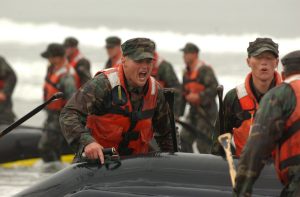When it comes to elite military units, two names often come up: Navy SEALs and Army Delta Rangers. Both are renowned for their skill, bravery, and effectiveness in some of the most challenging missions worldwide. But what sets them apart? In this article, we will explore the distinctions between Navy SEALs and Army Delta Rangers, examining their roles, training, and missions.

Understanding Elite Military Units
Elite military units are specialized groups within the military trained to perform high-stakes operations. They are often called upon for tasks that require precision, stealth, and strategic planning. The Navy SEALs and Army Delta Rangers are among the most well-known of these units, each with unique capabilities and missions.
Who Are the Navy SEALs?
The Navy SEALs, short for Sea, Air, and Land Teams, are a special operations force under the United States Navy. They are known for their versatility and ability to operate in all environments—be it sea, air, or land. The SEALs were established in 1962, and since then, they have been involved in numerous high-profile missions, including the operation that led to the capture of Osama bin Laden.
Training and Selection
Becoming a Navy SEAL is no small feat. The selection process is rigorous and designed to test both physical and mental endurance. It begins with Basic Underwater Demolition/SEAL (BUD/S) training, which lasts about six months. This training is notorious for its intensity, including grueling physical challenges like “Hell Week,” where candidates face long hours of physical training with little sleep.
Upon completing BUD/S, candidates undergo further specialized training, including parachute and diving techniques, to prepare them for various mission scenarios.
Who Are the Army Delta Rangers?
The Army Delta Rangers, officially known as the 1st Special Forces Operational Detachment-Delta (1st SFOD-D), are part of the United States Army. Commonly referred to as Delta Force, they are known for counter-terrorism, hostage rescue, and direct action operations. Delta Force was formed in 1977 and modeled after the British Army’s Special Air Service (SAS).
Training and Selection
Delta Force selection is equally demanding. Candidates are drawn from various branches of the military, primarily from the Army. The selection process is shrouded in secrecy but is known to involve a series of grueling physical and mental tests. Candidates must demonstrate high levels of endurance, problem-solving skills, and the ability to work under extreme pressure.
Those who pass the selection process undergo a six-month Operator Training Course (OTC), where they learn advanced combat skills, including marksmanship, explosives, and hand-to-hand combat.
Key Differences Between SEALs and Delta Rangers
While both units are elite and highly trained, there are several differences in their operations and capabilities.
Mission Focus
- Navy SEALs: Known for their maritime operations, SEALs are experts in amphibious assaults, reconnaissance, and unconventional warfare. They can operate in small teams for precision strikes and gather intelligence.
- Army Delta Rangers: Delta Force specializes in counter-terrorism and direct action missions. They are often deployed for hostage rescues, capturing high-value targets, and conducting raids. Their missions can be covert and are typically high-risk.
Organizational Structure
- Navy SEALs: Operate under the United States Naval Special Warfare Command. They are often deployed as part of naval operations but can also support joint missions with other branches.
- Army Delta Rangers: Part of the United States Army Special Operations Command. Delta Force often works closely with intelligence agencies like the CIA and can operate independently or alongside other special forces.
Training Emphasis
- Navy SEALs: Emphasize versatility in various environments, with a strong focus on water-based operations. Their training includes diving, swimming, and navigation in challenging conditions.
- Army Delta Rangers: Focus on land-based operations, with specialized training in urban warfare, close-quarter combat, and counter-terrorism tactics.
Equipment and Technology
Both units have access to state-of-the-art equipment and technology, but their gear is tailored to their specific operational needs. SEALs often use equipment designed for maritime operations, while Delta Force uses gear optimized for urban and counter-terrorism missions.
Real-World Impact and Notable Missions
Both Navy SEALs and Army Delta Rangers have been instrumental in numerous global operations, showcasing their exceptional skills and bravery.
Navy SEALs
One of the most notable SEAL operations was Operation Neptune Spear, which led to the death of Osama bin Laden in 2011. SEAL Team Six executed the mission with precision and efficiency, highlighting their capability to carry out high-stakes operations.
Army Delta Rangers
Delta Force has been involved in numerous covert missions, often classified and less publicized. However, their role in the 1980 Iran hostage rescue attempt, Operation Eagle Claw, is one of the more well-known missions. Despite its challenges, the operation underscored the complexity and high-risk nature of Delta missions.
Conclusion
In the debate of Navy SEALs vs. Army Delta Rangers, it’s clear that both units are crucial to national security and excel in their respective domains. While their missions and training differ, they share a common goal: to protect and serve with unmatched skill and dedication.
These elite military units continue to evolve, adapting to new threats and technologies, ensuring that they remain at the forefront of global military operations. Understanding the differences between SEALs and Delta Rangers enhances our appreciation for their unique contributions to national and global security.
